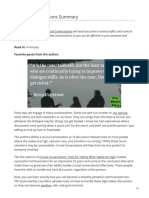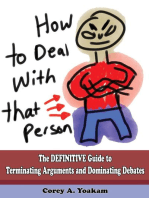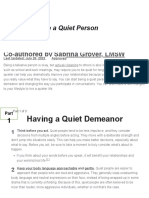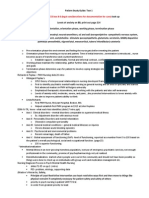7 TIPS FOR CONFLICT Resolution PRINT
7 TIPS FOR CONFLICT Resolution PRINT
Uploaded by
Gohar SaeedCopyright:
Available Formats
7 TIPS FOR CONFLICT Resolution PRINT
7 TIPS FOR CONFLICT Resolution PRINT
Uploaded by
Gohar SaeedOriginal Description:
Copyright
Available Formats
Share this document
Did you find this document useful?
Is this content inappropriate?
Copyright:
Available Formats
7 TIPS FOR CONFLICT Resolution PRINT
7 TIPS FOR CONFLICT Resolution PRINT
Uploaded by
Gohar SaeedCopyright:
Available Formats
7 TIPS FOR RESOLVING CONFLICT QUICKLY
By Stephen Hopson (Stephen Hopson is a former Wall Street stockbroker turned motivational speaker, author
and pilot. He shares his personal experiences in dealing with adversity through stories, observations, and tips.)
Everyone has to deal with difficult people, whether they are argumentative, abusive, stubborn, or
combative. In most cases, angry people are screaming to be heard. They want to be valued,
loved, and listened to. They want to feel important but aren’t able to express themselves
constructively. With the right attitude, it’s possible to get past these insecurities and reach an
understanding.
These 7 strategies will help you setting disputes quickly and peacefully for the benefit of
everyone involved:
1. Remain calm. Be still and say nothing. Let the storm run its course. Often times the angry
person wants to provoke you. Arguing is ineffective because it raises barriers.
2. Let the other person do the talking. He or she will soon grow tired of it. Sometimes that’s
all they want. To be heard. To feel important. Everyone wants to feel important. Some people
just express it in ways that are counterproductive.
3. Genuinely consider the other person’s point of view. Imagine yourself in his shoes. Never
say “you’re wrong.” In fact, try hard to look for areas of agreement and build on them.
4. There’s power in the words “Yes, yes, I see exactly what you’re saying. You mean…….”
This shows the other person you hear him/her. That’s all they usually want — to be validated. By
agreeing with them, you gradually break down the other person’s anger.
5. If the situation turns verbally abusive, put a stop to it. Firmly but calmly state: “You’re
very angry right now and you’re saying things you don’t mean (give them the benefit of the
doubt). I’m going to excuse myself. We can talk again after you calm down.” Then leave the
room or ask them to leave.
6. If you are wrong, quickly admit it and take responsibility. You could say, “You’re
absolutely right, it is my fault and here is what I’ll do to fix it.” Even if you’re NOT wrong, at
least give them the benefit of the doubt, “I may be wrong, let’s look at the facts together.” It’s
hard to argue with that!
These words have tremendous power. Not only does it validate the other person’s viewpoint but
it also diffuses the tension. You might be surprised by what happens afterwards. The person
could end up defending you. You’d be amazed how an attacker suddenly becomes an ally.
7. Food for thought: Think about how you’ve dealt with difficult people in the past. Were you
tempted to prove them wrong, trying to save face? Were you able to see through the facade and
recognize that all they want is to be heard, loved and validated? Have you tried the power of
visualization?
You might also like
- 12 Edition - John ChaffeeDocument37 pages12 Edition - John ChaffeeGabriel Tafalla0% (3)
- Chapter3&4 - Saripada, Dimple MDocument14 pagesChapter3&4 - Saripada, Dimple Mkpaoyna100% (10)
- Module 11 QuestionsDocument2 pagesModule 11 Questionsapi-325828984No ratings yet
- How To Deal With Impossible People - 14 Steps - WikiHowDocument5 pagesHow To Deal With Impossible People - 14 Steps - WikiHowgreenbeeNo ratings yet
- Chapter 1 - Module 3 Philosophies and Principles of ExtensionDocument6 pagesChapter 1 - Module 3 Philosophies and Principles of ExtensionRolyn Magaro100% (3)
- Difficult PeopleDocument3 pagesDifficult PeopleHugh Fox IIINo ratings yet
- Anger Management ToolboxDocument11 pagesAnger Management Toolboxkalina.rangelova100% (1)
- Conversation RulesDocument1 pageConversation RulesAiza HernandezNo ratings yet
- How To Cope With Arrogan... Ith Pictures) - WikiHowDocument13 pagesHow To Cope With Arrogan... Ith Pictures) - WikiHowshees1993No ratings yet
- 26.07.10.life Style Management Series-Avoiding Conflicts & ArgumentsDocument4 pages26.07.10.life Style Management Series-Avoiding Conflicts & Argumentsmaheshwari prasad shuklaNo ratings yet
- Dealing With Difficult People - 2020Document2 pagesDealing With Difficult People - 2020ilsourisNo ratings yet
- The 12 Bad Habits That Hold Good People Back SummaryDocument5 pagesThe 12 Bad Habits That Hold Good People Back Summarytoftb7No ratings yet
- 7 Smart Ways To Deal With Toxic PeopleDocument4 pages7 Smart Ways To Deal With Toxic PeopleFahrudin Feratović100% (2)
- The Story Spirits - Afro Asian LiteratureDocument5 pagesThe Story Spirits - Afro Asian LiteratureAiram Cristine MargateNo ratings yet
- EmpathyDocument5 pagesEmpathyPaul MachariaNo ratings yet
- Dealing With Difficult PeopleDocument2 pagesDealing With Difficult PeopleMohamed AbdiazizNo ratings yet
- Coping With Difficult People: Rob Houser August 18, 1999Document36 pagesCoping With Difficult People: Rob Houser August 18, 1999YusranNo ratings yet
- Fighting FairDocument4 pagesFighting FairjackNo ratings yet
- 7 Smart Ways To Deal With Toxic PeopleDocument2 pages7 Smart Ways To Deal With Toxic PeopleJustin WhitakerNo ratings yet
- How To Be Less Annoyed With People: StepsDocument6 pagesHow To Be Less Annoyed With People: StepsdarkhbkNo ratings yet
- Dealing with Difficult People: Learn how to confidently implement different strategies for dealing with difficult people.From EverandDealing with Difficult People: Learn how to confidently implement different strategies for dealing with difficult people.Rating: 4 out of 5 stars4/5 (1)
- Dealing With Difficult PeopleDocument30 pagesDealing With Difficult PeopleSafeer Ullah Siddiqui100% (2)
- A Joosr Guide to... How to Deal with Difficult People by Gill Hasson: Smart Tactics for Overcoming the Problem People in Your LifeFrom EverandA Joosr Guide to... How to Deal with Difficult People by Gill Hasson: Smart Tactics for Overcoming the Problem People in Your LifeNo ratings yet
- 7 Smart Ways To Deal With Toxic PeopleDocument3 pages7 Smart Ways To Deal With Toxic PeoplePrinsesaJuu50% (2)
- 7 Essentials For Understanding EgoDocument2 pages7 Essentials For Understanding EgotasleemshahzadNo ratings yet
- How To Manage Anger - A Step by Step Guide: How To Manage Series, #1From EverandHow To Manage Anger - A Step by Step Guide: How To Manage Series, #1No ratings yet
- 8 Situations When You Should Keep Your Mouth ShutDocument2 pages8 Situations When You Should Keep Your Mouth Shutketiket7No ratings yet
- AssertivenessDocument3 pagesAssertivenesspakox86377No ratings yet
- Anger ManagementDocument4 pagesAnger Managementvenkdeshraja100% (1)
- Marriage ConflictsDocument3 pagesMarriage ConflictsSumati Kanwar ChauhanNo ratings yet
- Dealing With Difficult PPLDocument6 pagesDealing With Difficult PPLkNo ratings yet
- DealingWithDifficult PeopleDocument11 pagesDealingWithDifficult Peoplestargazerlilies07No ratings yet
- 10 Fatal Mistakes That Kill ConversationsDocument7 pages10 Fatal Mistakes That Kill ConversationsTheodoreGeorgasNo ratings yet
- Crucial Conversations Summary: 1-Sentence-Summary: Crucial Conversations Will Teach You How To Avoid Conflict and Come ToDocument4 pagesCrucial Conversations Summary: 1-Sentence-Summary: Crucial Conversations Will Teach You How To Avoid Conflict and Come Toaashish1507No ratings yet
- How To Handle Difficult People: A Complete Guide To Dealing With Annoyingly Crazy and Difficult PeopleFrom EverandHow To Handle Difficult People: A Complete Guide To Dealing With Annoyingly Crazy and Difficult PeopleNo ratings yet
- How to Argue with Right-Wingers – A Winning Strategy to Dealing With the Other SideFrom EverandHow to Argue with Right-Wingers – A Winning Strategy to Dealing With the Other SideRating: 2.5 out of 5 stars2.5/5 (7)
- PERDEVDocument11 pagesPERDEVAnjelie CheongNo ratings yet
- 9 Helpful Tips To Deal With Negative PeopleDocument3 pages9 Helpful Tips To Deal With Negative PeopleNARENDRA MOHANTYNo ratings yet
- 6 Types of Negative PeopleDocument6 pages6 Types of Negative PeopleDocky BridgeNo ratings yet
- How To Ignore People and Unpublished ArticleDocument22 pagesHow To Ignore People and Unpublished ArticleAli RazaNo ratings yet
- Book Summary Just Listen by Mark Goulston - JFD Performance SolutionsDocument6 pagesBook Summary Just Listen by Mark Goulston - JFD Performance Solutionsakashsha914No ratings yet
- How To Be Happy Session #3Document13 pagesHow To Be Happy Session #3maria praveenNo ratings yet
- Beat A NarcissistDocument10 pagesBeat A Narcissistrocktheparty4444No ratings yet
- 25 Psychological LifehacksDocument9 pages25 Psychological LifehacksАки Иргашев100% (1)
- How To Win An Argument - 10 Tips For Winning An ArgumentDocument3 pagesHow To Win An Argument - 10 Tips For Winning An Argumentgeo icemanNo ratings yet
- OB Assingment#2 ConflictDocument3 pagesOB Assingment#2 ConflictAquib AliNo ratings yet
- Our Inability T-WPS OfficeDocument4 pagesOur Inability T-WPS Officelixciel.cesistaNo ratings yet
- Coping with the Difficult People in Your Life: Tips to Positively React to Their Irritating Behavior: Stay PositiveFrom EverandCoping with the Difficult People in Your Life: Tips to Positively React to Their Irritating Behavior: Stay PositiveNo ratings yet
- Be Assertive The Right Way WorkbookDocument28 pagesBe Assertive The Right Way WorkbookfurkanNo ratings yet
- Gain Control of Your EmotionsDocument18 pagesGain Control of Your EmotionsAfzal Akthar100% (1)
- Expressing Anger and Resolving ConflictDocument6 pagesExpressing Anger and Resolving ConflictRAYSHA ERZA PUSPITA S1 Pendidikan Bahasa InggrisNo ratings yet
- Dealing With That Person: The Definitive Guide to Terminate Arguments and Dominate DebatesFrom EverandDealing With That Person: The Definitive Guide to Terminate Arguments and Dominate DebatesNo ratings yet
- Dealing With Difficult Situations PDFDocument33 pagesDealing With Difficult Situations PDFmadmaxpsuNo ratings yet
- People - Different TypesDocument5 pagesPeople - Different Typesnoelia.latronico22No ratings yet
- AngerManagement BBNDocument23 pagesAngerManagement BBNBijaya Bhusan NandaNo ratings yet
- Quit Being A Pushover: How To Be Assertive: 121 Comments A Man's Life Personal DevelopmentDocument7 pagesQuit Being A Pushover: How To Be Assertive: 121 Comments A Man's Life Personal DevelopmentDal Makhani100% (1)
- Many Arguments Between Couples Stem From Simple Misunderstandings Based On Different Communication StylesDocument16 pagesMany Arguments Between Couples Stem From Simple Misunderstandings Based On Different Communication Styleskhumairagirl100% (2)
- F) Dealing With Difficult People: Understand Problem PersonalityDocument13 pagesF) Dealing With Difficult People: Understand Problem PersonalityNor Bibi Fazal RahmanNo ratings yet
- How To Become A Quiet PersonDocument7 pagesHow To Become A Quiet PersonHoward BassNo ratings yet
- Interacting With People Who Annoy YouDocument2 pagesInteracting With People Who Annoy Yougord42No ratings yet
- How To Deal With Negative PeopleDocument12 pagesHow To Deal With Negative PeopleasoomooNo ratings yet
- International StrategyDocument33 pagesInternational StrategyGohar SaeedNo ratings yet
- Women Gender & DevelopmentDocument37 pagesWomen Gender & DevelopmentGohar SaeedNo ratings yet
- Conflict Building MeasuresDocument10 pagesConflict Building MeasuresGohar SaeedNo ratings yet
- Chapter 1 - Lecture 2 - Competitive AdvantageDocument9 pagesChapter 1 - Lecture 2 - Competitive Advantagesanya-nisar-2818No ratings yet
- Logistics Management)Document1 pageLogistics Management)Gohar SaeedNo ratings yet
- Competitive and Cooperative DynamicsDocument7 pagesCompetitive and Cooperative DynamicslingodrummerNo ratings yet
- Autism-Baron Cohen The Emphathizing-Systemizing Es Theory - SBC - ARC-8-11Document4 pagesAutism-Baron Cohen The Emphathizing-Systemizing Es Theory - SBC - ARC-8-11AnaNo ratings yet
- Janet and Psychic EnergyDocument2 pagesJanet and Psychic EnergydreamburoNo ratings yet
- Proposal 1.0. 1.1. Title:: (CITATION Gem12 /L 16393)Document15 pagesProposal 1.0. 1.1. Title:: (CITATION Gem12 /L 16393)Nishadha21No ratings yet
- 4 Utarid Listening and SpeakingDocument1 page4 Utarid Listening and SpeakingKalisKaliappanNo ratings yet
- Facilitating Learner Centered Teaching: Learner Centered Approach With Emphasis On Trainers Methodology IDocument51 pagesFacilitating Learner Centered Teaching: Learner Centered Approach With Emphasis On Trainers Methodology IArnie JaneNo ratings yet
- Into Great Depth of Your Being - Arul Dev PDFDocument542 pagesInto Great Depth of Your Being - Arul Dev PDFAditya Singh100% (2)
- Reflection Paper Ethics - Paolo JavierDocument3 pagesReflection Paper Ethics - Paolo JavierPJ Javier100% (1)
- Love and Intimacy, Psychology Of: Panos Kordoutis, Panteion University of Social and Political Sciences, Athens, GreeceDocument7 pagesLove and Intimacy, Psychology Of: Panos Kordoutis, Panteion University of Social and Political Sciences, Athens, Greeceachmad fatoniNo ratings yet
- Top Concerns of Social Studies TeachersDocument3 pagesTop Concerns of Social Studies TeachersJohnny AbadNo ratings yet
- Week 1 Origins of Hospitality and HousekeepingDocument12 pagesWeek 1 Origins of Hospitality and HousekeepingEmmanuel CherianNo ratings yet
- SYSTEMDocument2 pagesSYSTEMVikram Raj SinghNo ratings yet
- Sample of RRLDocument10 pagesSample of RRLAwesome100% (1)
- What Are Some Psychosocial Implications of Congenital Craniofacial Anomalies?Document69 pagesWhat Are Some Psychosocial Implications of Congenital Craniofacial Anomalies?Neil GillespieNo ratings yet
- Personality DisordersDocument35 pagesPersonality DisordersEsraRamosNo ratings yet
- Pilot StudyDocument11 pagesPilot StudySatya Prakash86% (7)
- Guidelines To Inclusive LanguageDocument22 pagesGuidelines To Inclusive LanguageMargie FernandoNo ratings yet
- How To Use The PRECEDE PROCEED MODELDocument7 pagesHow To Use The PRECEDE PROCEED MODELBea Christine AmanteNo ratings yet
- Bulkowsky PsicologiaDocument41 pagesBulkowsky Psicologiaamjr1001No ratings yet
- 4164 U1 EPVisit Candidate's NameDocument3 pages4164 U1 EPVisit Candidate's NameUday KiranNo ratings yet
- Chapter 1 HRM544Document31 pagesChapter 1 HRM544fazleyanaNo ratings yet
- Lesson Plan Step BDocument6 pagesLesson Plan Step Bapi-427927675No ratings yet
- Study Guide Test 1Document11 pagesStudy Guide Test 1jwasylow13No ratings yet
- Vivek Kumar House No. 163 Sec-13 Vasundhra, Ghz. Mob: 7409020703 EmailDocument3 pagesVivek Kumar House No. 163 Sec-13 Vasundhra, Ghz. Mob: 7409020703 EmailNitin MahawarNo ratings yet
- Chapter10 Psychological Counseling and PsychotherapyDocument18 pagesChapter10 Psychological Counseling and PsychotherapyAlifreeNo ratings yet
- Paco Catholic School High School Department PAASCU Accredited Merit Record VII-8 (2016-2017)Document6 pagesPaco Catholic School High School Department PAASCU Accredited Merit Record VII-8 (2016-2017)ۦۦ ۦۦNo ratings yet






























































































